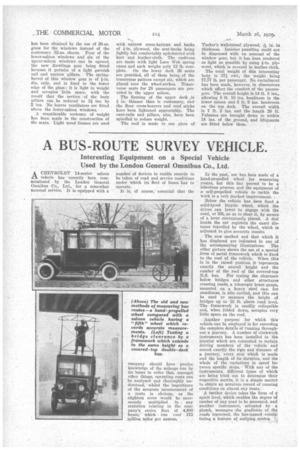A BUS-ROUTE SURVEY VEHICLE.
Page 66

If you've noticed an error in this article please click here to report it so we can fix it.
Interesting Equipment on a Special Vehicle Used by the London General Omnibus Co., Ltd.
ACHEVROLET 14-seater saloon vehicle has recently been commissioned by the London General Omnibus Co., Ltd., for a somewhat unusual service. It is equipped with a
number of devices to enable records to be taken of road and service conditions under which its fleet of buses has to operate.
It is, of course, essential that the • company should have precise knowledge of the mileage run by its buses in order that, amongst other things, operating costs can be analysedand thoroughly understood, whilst the importance of the accurate measurement of a route is obvious, as the slightest error would be enormously multiplied in any • statistics relating to the company's entire fleet of 4,400. buses, which run over 173 million miles per minute. In the past, use has been made of a hand-propelled wheel for measuring routes, but this has proved to be a laborious process, and the equipment of a self-propelled vehicle to _tackle the work is a very marked improvement.
Below the vehicle has been fixed a solid-tyred bicycle wheel, which the driver can lower to engage with the road, or lift, so as to clear it, by means of a lever conveniently placed. A dial inside the car registers the exact distance travelled by the wheel, which is adjusted to give accurate results.
The new method and that which it has displaced are indicated in one of the accompanying illustrations. The other picture shows the use of a special form of metal framework which is fixed to the roof of the vehicle. When this is in the raised position it represents exactly the overall height and the camber of the roof of the covered-top
N.S. bus. For testing the clearance below bridges and other structures crossing roads, a telescopic brass gauge, mounted on a heavy steel case for steadiness, is also carried, and this can be used to measure the height of bridges up to 18 ft. above road leveL The framework is readily collapsible and, when folded down, occupies very little space on the roof.
Another purpose for -which this vehicle can be employed is for recording the complete details of running throughout a journey. A number of clockwork instruments has been installed in the interior which are connected to certain driving members of the vehicle and record exactly the tisee and distance of a journey, every stop which is made and the length of its duration, and the whole of the variations in speed between specific stops. With any of the instruments, different types of which are being tried out to determine their respective merits, it is a simple-matter to obtain an accurate.record of running conditions on almost any route..
A farther device takes the form of a spirit level, which enables the degree of camber of any road to be measured, and another instrument, actuated by a plumb, measures the gradients of the roads traversed, the last-named eoneti. tuting a feature of outlying routes.




























































































































